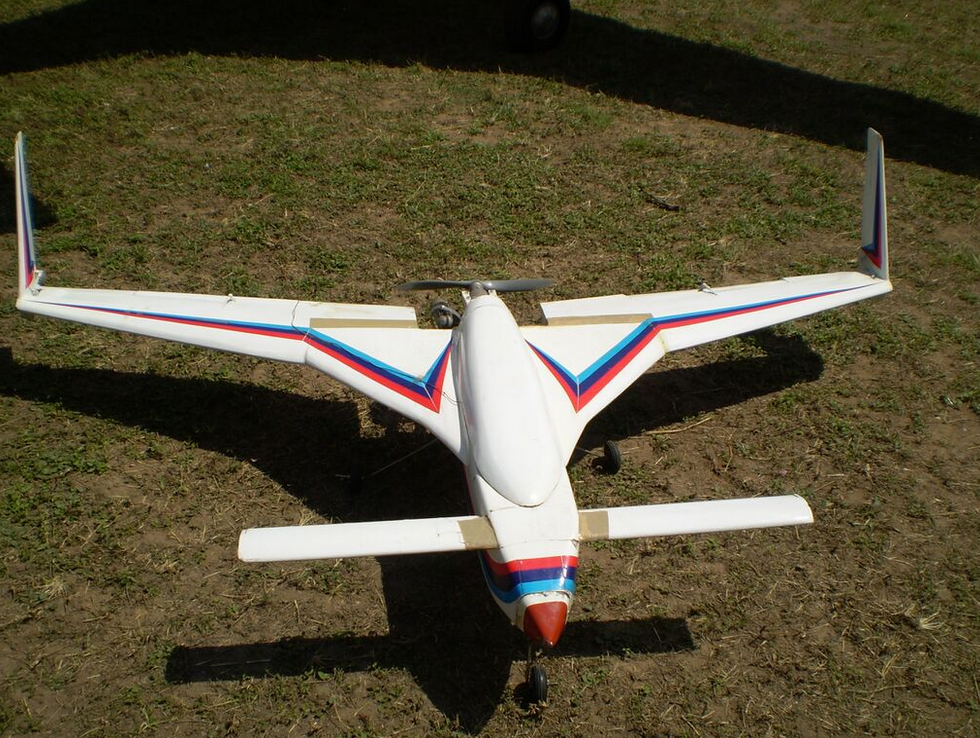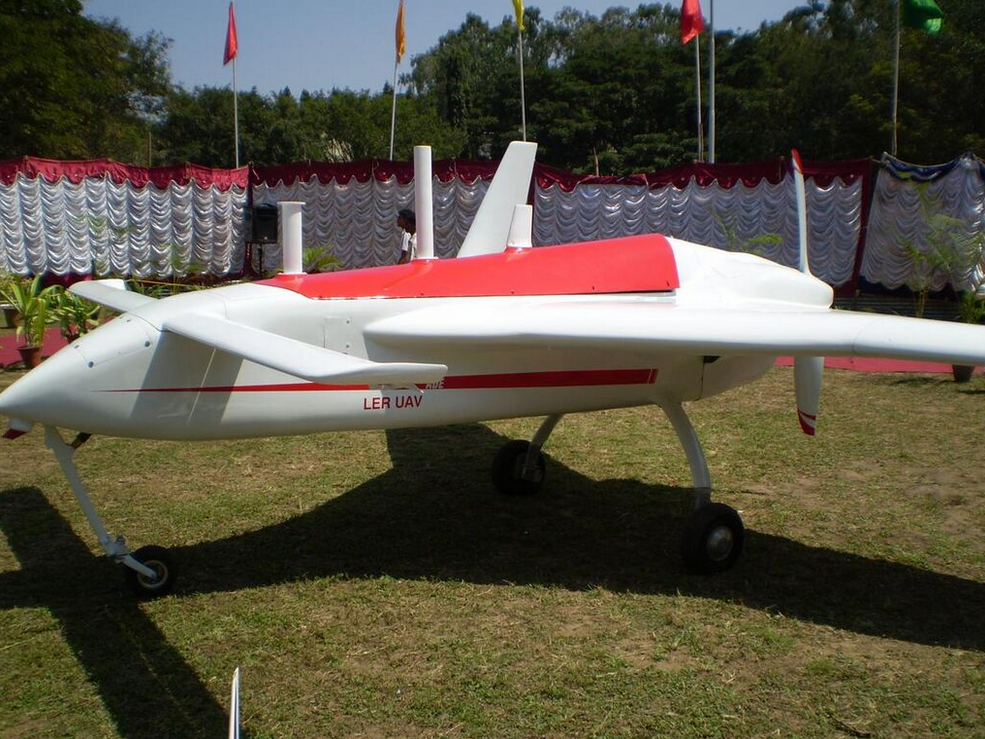The DRDO Rustom (English: Warrior) is a Medium Altitude Long Endurance unmanned air vehicle (UAV) being developed by Defence Research and Development Organisation for the three services, Indian Army, Indian Navy and the Indian Air Force of the Indian Armed Forces. Rustom is derived from the NAL's LCRA (Light Canard Research Aircraft) developed by a team under the leadership of late Prof Rustom Damania in the 1980s. The UAV will have structural changes and a new engine. Rustom will replace/supplement the Heron UAVs in service with the Indian armed forces.
- unmanned air vehicle
- uav
- warrior
1. Design and Development
Rustom-1's basic design is derived from the NAL light canard research aircraft (LCRA). The aircraft has been named after Rustom Damania, a former professor of IISc, Bangalore who died in 2001. DRDO decided to name the UAV after him because it is derived from National Aerospace Laboratories' light canard research aircraft (LCRA) developed under Rustom Damania's leadership in the 1980s.
With the Rustom MALE UAV project, DRDO intends to move away from traditional ways of developing products whereby laboratories under DRDO, like the Aeronautical Development Establishment (ADE), which is involved in this project, develop and finalize the product and transfer technology to a production agency.[1]
DRDO will follow a practice of concurrent engineering where initial design efforts also take into consideration production issues, with the production agency participating in the development of the system right from the design stage. The agency will also follow up issues related to infrastructure and expertise for the product and its support, thereby overcoming time delays in crucial projects.[2]
Rustom-1 which bears an uncanny resemblance to Rutan Long-EZ designed by Burt Rutan (citation needed) has a wingspan of 7.9 m (26 ft)[3] and weighs 720 kg (1,590 lb),[3] will be launched by the conventional method and not the launcher as in the case of the DRDO Lakshya. Rustom will be able to see the enemy territory up to a distance of 250 km (160 mi) and carry a variety of cameras and radar for surveillance.[4]
Rustom-H, built on a different design, is a Medium-Altitude Long-Endurance (MALE) Unmanned Aerial Vehicle (MALE UAV), a twin engine system designed to carry out surveillance and reconnaissance missions. Rustom H will have a payload capacity of 350 kg (770 lb).[1]
The range of advanced technologies and systems include the following:[3]
- Aerodynamic configurations, High aspect ratio wing, Composite airframe integrated with propulsion system, De-icing system for wings
- Highly reliable systems with built-in redundancy for flight critical systems like flight control and navigation, data links, power management, - and mission critical payload management system
- Digital Flight Control and Navigation System, Automatic Take off and Landing (ATOL)
- Digital communication technologies for realizing data links to control and operate the mission and relay UAVs
- Payloads with high resolution and precision stabilized platforms.
2. Variants
There will be three variants of the Rustom UAV.[5]
- Rustom-I: Tactical UAV with endurance of 12 hours (based on NAL's LCRA )[1][6]
- Rustom-H: Larger UAV with flight endurance of over 24 hours (completely different design from Rustom-1), higher range and service ceiling than Rustom-1.
- Rustom-II: An unmanned combat air vehicle based on Rustom-H model. It is often compared with Predator drones by Indian scientists and media.[1][5][7][8]
3. Current Status

The Indian government has allowed the development of the Rustom MALE UAV project in association with a production agency cum development partner (PADP). The ADE officials indicated that the requests for proposals (RFP) would shortly be issued to four vendors which are the Tata Power Strategic Engineering Division, Larsen & Toubro Limited, Godrej Aerospace Limited and Hindustan Aeronautics Limited-Bharat Electronics Limited (joint bid) who were chosen out of the 23 firms that responded.
Currently, negotiations are underway between these companies and the three Indian armed forces since the private majors are looking for support and commitment from them before they start executing any development and production plans. This is because of the fact that the chosen PADP will also have a financial stake in the Rustom project. The Armed Forces would also be asked to take up a financial stake and the Indian government may have to guarantee that a specific number of Rustom UAVs will be bought.[2][9]
3.1. Rustom-1
The first flight of Rustom-I UAV took place on 16 November 2009 at the Taneja Aerospace Air Field near Hosur. The demonstration resulted in the prototype crashing to the ground. Stated by the DRDO, the taxiing and takeoff was exactly as planned. Due to misjudgment of altitude of the flight, the on-board engine was switched off through ground command which made the on-board thrust developed to go to zero.[10] Despite the mishap, the state-owned Defence Research and Development Organisation stated: "The flight proved the functioning of a number of systems such as aerodynamics, redundant flight control, engine and datalink, which go a long way towards the development of a complex UAV."

The second "maiden" flight took place on 15 Oct 2010. In this test flight, the UAV flew for 30 minutes at an altitude of 910 m (3,000 ft). The test was conducted in Hosur.[11] The Indian army was impressed with Rustom-1 and will use it as a MALE UAV.
Rustom-1 made its 5th successful flight on morning of 12 November 2011, flying for 25 minutes at 700 m (2,300 ft) AGL at a speed 190 km/h (100 kn). It completed its 8th successful flight on 8 Dec 2011. It flew at an altitude of 1,800 m (6,000 ft) (max) and at a speed of 170 km/h (90 kn) (max) during its 30 minutes flight near Hosur, claims DRDO. The highlight of the flight was that Rustom-1 was test flown with the 'gimbal payload assembly carrying daylight TV & Infra-Red camera for the first time. Good quality pictures were received from the camera in gimbal payload assembly.
The 14th Successful Flight of Rustom-1 was reported on 8 May 2012, with the attainment of about 3,500 m (11,500 ft) above ground level and speed of above 140 km/h (87 mph) during 2 hours 10 minutes of operation.[12]
3.2. Rustom-2
Rustom 2 or TAPAS-BH-201 is a medium-altitude long-endurance unmanned aerial vehicle (UAV), designed to carry out surveillance and reconnaissance roles for the Indian Armed Forces. It is capable of carrying different combination of payloads including synthetic aperture radar, electronic intelligence systems and situational awareness systems. The UAV has an endurance of 24 hours and is similar to the American predator series of drones.[13][14][15]
DRDO carried out a successful test flight of Rustom 2 on 25 February 2018, at the Aeronautical Test Range(ATR) located in Chalakere, Chitradurga district. This was the first flight of the UAV in user configuration with higher power engine.[14][16] During its development trials Rustom 2 crashed near Jodichikkenahalli in Karnataka's Chitradurga district on 17 September 2019. No one was hurt. The UAV was being tested at Challakere Aeronautical Test Range, a DRDO outdoor testing facility.[17]
4. Specifications
Specifications of Rustom-1 and Rustom-H are as follows:
Data from Defstrat.com,[3] idp.justthe80.com[18] and stargazer2006.online.fr[19]
General characteristics
- Crew: none
- Payload: 95 kg (209 lb) and 350 kg (770 lb) (for Rustom-1 & Rustom-H respectively)
- Length: 5.12 m (16.8 ft) and 9.5 m (31.2 ft)[3] (for Rustom-1 & Rustom-H respectively)
- Wingspan: 7.9 m (25.9 ft) and 20.6 m (67.6 ft) (for Rustom-1 & Rustom-H respectively)
- Height: 2.4 m (7 ft 10.5 in) (for Rustom-1)
- Empty weight: 720 kg (1,590 lb) & 1,800 kg (4,000 lb) (for Rustom-1 & Rustom-H respectively)
- Powerplant:
Performance
- Maximum speed: 150 km/h (93 mph) and 225 km/h (140 mph) (for Rustom-1 & Rustom-H respectively)
- Cruise speed: 125–175 km/h (78–109 mph) (Rustom H)
- Range:
- Ferry range: 1,000 km (620 mi)[18] (for Rustom-H)
- Service ceiling: 7,925 m (26,000 ft) and 10,668 m (35,000 ft) (for Rustom-1 & Rustom-H respectively)
The content is sourced from: https://handwiki.org/wiki/Engineering:DRDO_Rustom
References
- "Unmanned: The Future of Air Wars". SP's Aviation. Archived from the original on 5 June 2013. https://web.archive.org/web/20130605165251/http://www.spsaviation.net/exclusive/?id=164&h=Unmanned%3A-The-Future-of-Air-Wars. Retrieved 10 February 2013.
- DRDO's Rustom UAV To Roll Out Soon . India Defence Online. Retrieved on 2011-10-20. http://indiadefenceonline.com/428/drdos-rustom-uav-to-roll-out-soon/
- "Unmanned Aerial Vehicles Made in India". South Asia Defence Strategic Review. Archived from the original on 14 May 2012. https://web.archive.org/web/20120514023950/http://www.defstrat.com/exec/frmArticleDetails.aspx?DID=234. Retrieved 9 March 2012.
- Aero India 2009 News: Rustom to lock horns with Mantis, Herti . Indianaviationnews.net. Retrieved on 2011-10-20. http://indianaviationnews.net/aeroindia2009/2009/02/rustom-to-lock-horns-with-mantis-herti.html
- India Eyes Armed Rustom UAV http://www.aviationweek.com/aw/generic/story.jsp?topicName=unmanned&id=news/awst/2010/10/25/AW_10_25_2010_p30-263965.xml&headline=India%20Eyes%20Armed%20Rustom%20UAV&channel=&from=topicalreports
- [2] India plans to develop solar-powered UAVs
- "India may soon have its own 'Predator drones'". Rediff News. November 15, 2011. http://www.rediff.com/news/slide-show/slide-show-1-india-to-soon-have-its-won-predator-drones/20111115.htm. Retrieved 9 March 2012.
- "ADE Finalizes Rustom-2 UAV Flight, Reveals Future Drone Projects for Defence". Defence Now. February 25, 2012. http://www.defencenow.com/news/549/ade-finalizes-rustom-2-uav-flight-reveals-future-drone-projects-for-defence.html. Retrieved 9 March 2012.
- "Significant step toward indigenous UAV". http://www.thehindu.com/news/national/article43328.ece.
- "Indias-uav-demonstrator-crashes-during-trials". http://www.algerie-defense.com/2009/11/indias-uav-demonstrator-crashes-during-trials/.
- News / National : Rustom 1 test-flown . The Hindu (2010-10-18). Retrieved on 2011-10-20. http://www.thehindu.com/news/national/article834821.ece
- http://drdo.gov.in/drdo/English/dpi/press_release/rustum-1_14.pdf DRDO Press Release: 14th Successful Flight of RUSTOM-1
- "Archived copy". https://economictimes.indiatimes.com/news/defence/drdo-successfully-carries-out-test-flight-of-rustom-2-drone/articleshow/63068375.cms.
- "DRDO successfully carries out test flight of indigenous Rustom-2 drone" (in en-US). The Indian Express. 2018-02-25. http://indianexpress.com/article/india/drdo-successfully-carries-out-test-flight-of-indigenous-rustom-2-drone-5077545/.
- "DRDO successfully carries out test flight of Rustom 2 drone" (in en). deccanchronicle.com/. 2018-02-25. https://www.deccanchronicle.com/nation/current-affairs/250218/drdo-successfully-carries-out-test-flight-of-rustom-2-drone.html.
- "DRDO Successfully Test Flight Rustom 2". http://pib.nic.in/newsite/PrintRelease.aspx?relid=176782.
- "DRDO unmanned aerial vehicle Rustom-2 crashes in Karnataka". 2019-09-17. https://www.businesstoday.in/latest/trends/drdo-unmanned-aerial-vehicle-rustom-2-crashes-karnataka/story/379525.html.
- "Rustom MALE UAV". Indian Defense Projects Sentinel. http://idp.justthe80.com/unmanned-aerial-systems/rustom-male-uav#TOC-Rustom-H-Capabilities. Retrieved 9 March 2012.
- "DRDO-ADE 'Rustom-I' and 'Rustom-H'". Stargazer. Archived from the original on 30 July 2012. https://web.archive.org/web/20120730134046/http://stargazer2006.online.fr/derivatives/rustom.htm. Retrieved 9 March 2012.
- "Aero India: the DRDO displayed the Rustom-1 MALE UAV". Russian Unmanned Vehicle Systems Association. 11 March 2011. http://en.ruvsa.com/news/development/aero_india_the_drdo_displayed_the_rustom_a_male_uav/. Retrieved 9 March 2012.
- "India Now Wants Hundreds Of UAVs". Aviation Week. May 20, 2011. http://www.aviationweek.com/aw/generic/story_channel.jsp?channel=defense&id=news/dti/2011/05/01/DT_05_01_2011_p19-313799.xml. Retrieved 9 March 2012.
